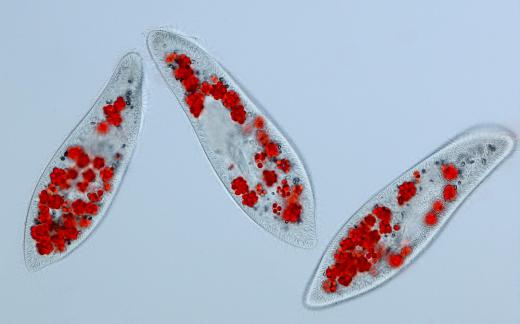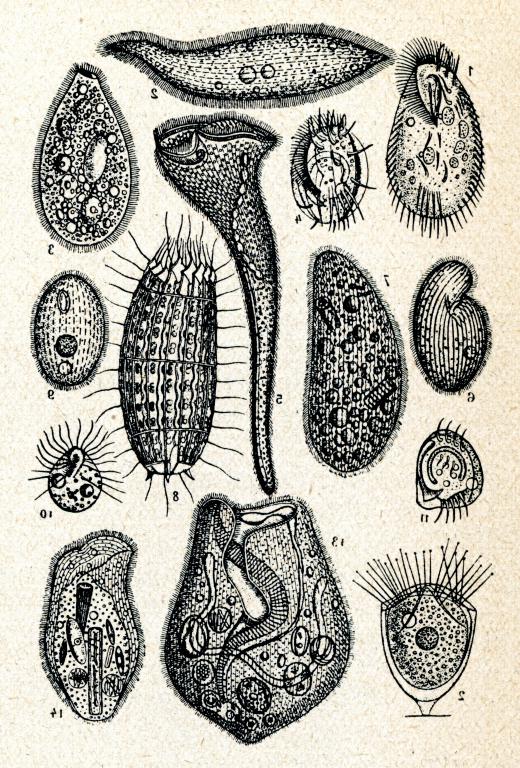What Is the Kingdom Protoctista?
Kingdom Protoctista is a biological classification for unicellular microorganisms with eukaryotic ancestry. Referencing eukaryotic ancestry simply means the organism is made up of eukaryotic cells: those cells that feature a nucleus and surrounding membrane. Virtually all living organisms, with the exception of prokaryotes, are made up of eukaryotic cells. The primary distinguishing factor of Kingdom Protoctista organisms is that protoctists are typically unicellular aquatic microorganisms.
Organisms arranged under Kingdom Protoctista included water molds, slime molds, algae, and similar eukaryotic unicellular microorganisms. Records indicate the smallest organism in Kingdom Protoctista are protists, microscopic single cell organisms such as protozoa. Protoctists live exclusively in aquatic conditions, although certain species exclusively choose freshwater, marine, or watery tissue environments. Large numbers of protoctists are parasitical, living in the watery tissues of host animals and plants.

For decades, scientists arranged all living organisms into five primary biological kingdoms, which were then subdivided into descending categories including phylum, class, order, family, and other categories. Primary kingdoms consisted of animal, plant, fungi, prokaryotes, or protoctista. Elementary school children and even high school and college students were, and frequently still are, taught the five kingdom biological classification scheme in science classes around the world.

As part of the five kingdom scheme, Kingdom Protoctista served as a kingdom of exclusion. Any living organism that was not animal, fungi, plant, or prokaryote was arranged under Kingdom Protoctista by default. Animals and plants form from embryos, while fungi form from spores. Prokaryotes have specific structural characteristics at the cellular level, the most notable being the lack of a nuclei. Members of Kingdom Protoctista do not form from embryos or spores and feature eukaryotic cells rather than prokaryote cells, thus warranting a separate kingdom classification.

Discoveries of unicellular microorganisms dating back to the 1960s and 1970s were found to have multicellular derivatives. Numerous such discoveries changed the way some scientists viewed the old five kingdom scheme. Since the 1970s, some biologists, zoologists, and other scientific researchers have argued for a new multi-kingdom classification scheme. In fact, many such researchers have chosen to use various multi-kingdom schemes adopted by certain segments of the scientific community.
One point of argument in favor of revamping historical understandings of Kingdom Protoctista is the discovery of unicellular organisms with multicellular derivatives. Some of these derivative organisms meet criteria for plant phyla. Other organisms discovered show such unique tissue structures compared to other members of Kingdom Protoctista that researchers argue these organisms deserve a separate kingdom classification.
AS FEATURED ON:
AS FEATURED ON:













Discussion Comments
@kentuckycat - I think for the most part algae are just used as food for different animals, but I know seaweed is a type of algae, and that has a lot of uses. I have had it in salads and other recipes before.
I remember after the BP Gulf oil spill, there was some type of algae that actually "ate" the oil and made the cleanup go a lot faster than anyone had anticipated. I guess that is a plus. I've heard of them being used in a couple other manufacturing processes like biofuels, as well.
On the other hand, though, I think a lot of algae are just an economic loss. Someone already mentioned algae filling up ponds, and it takes money to get rid of that. I know I have read, too, about some other type of algae that build huge colonies and float toward shorelines and can kill a lot of animals.
@JimmyT - We were actually just talking about this whole thing in my biology class the other day. My teacher said that this is the first year she has taught domains even though the idea has been around for a long time. Since the 70s I think she said. I guess a lot of the textbook publishers weren't including the information until it got more popular.
Since we just learned it, I don't quite remember all the details, but I know the domains are bacteria, eukaryotes, and something called archaea. Apparently the archaea are sort of like bacteria but evolved differently. I'm pretty interested to learn about them.
According to that system, though, the protists would have to belong in the eukaryote domain, since they have a nucleus.
@kentuckycat - It sounds like maybe you are confusing algae with moss. A lot of people use the two words interchangeably, when in fact they are two very different types of organisms. Mosses do belong to the plant kingdom as do a lot of their close relatives like club mosses and lichens. The stuff that grows on ponds is actually algae, but is usually called moss.
As far as the new groupings go, I think the most accepted system currently involves domains that are one level higher than kingdoms. Like you, when I was in high school we just learned about kingdoms, but once I took some college biology classes, we were expected to know the domains.
Unfortunately, I don't need to know the domains too often, so I've forgotten exactly what they are and their characteristics. I'm not even sure where protists would go in the grouping. Maybe someone else can help.
I always thought that algae were considered part of the plant kingdom. They sort of look like some plants, and I thought they usually had some sort of a root system. Maybe not though. I don't why I would have thought that.
How long have scientists been putting organisms in the five kingdom classification system? I know we talked about those five different kingdoms when I was in school. What would be the new kingdom groupings according to some of the scientists that the article mentioned? I don't really know enough about biology to even come up with a good guess about other ways to separate various organisms.
Also, do organisms in the protista kingdom have any good economic uses? I would guess not, but you never know.
Post your comments